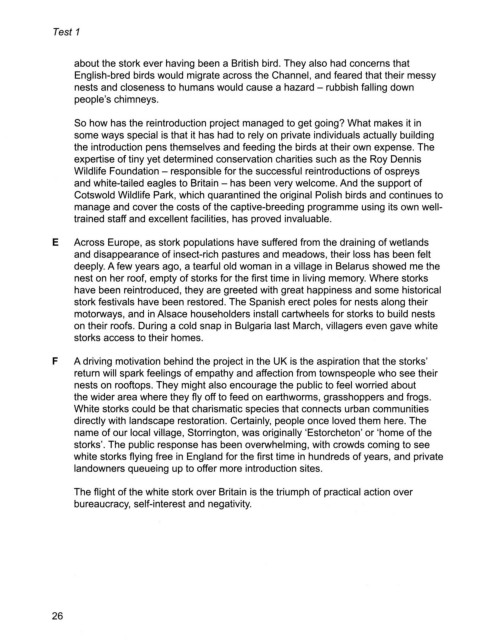Page 321 - Cam General 15-16-17-18-19
P. 321
Test 1
about the stork ever having been a British bird. They also had concerns that
English-bred birds would migrate across the Channel, and feared that their messy
nests and closeness to humans would cause a hazard - rubbish falling down
people’s chimneys.
So how has the reintroduction project managed to get going? What makes it in
some ways special is that it has had to rely on private individuals actually building
the introduction pens themselves and feeding the birds at their own expense. The
expe「tise of tiny yet determined conservation charities such as the Roy Dennis
Wildlife Foundation 一 responsible for the successful reintroductions of ospreys
and white-tailed eagles to Britain - has been ve「y welcome. And the support of
Cotswold Wildlife Park, which quarantined the original Polish birds and continues to
manage and cover the costs of the captive-breeding programme using its own well-
trained staff and excellent facilities, has proved invaluable.
E Across Europe, as sto「k populations have suffered from the draining of wetlands
and disappearance of insect-rich pastures and meadows, their loss has been felt
deeply. A few years ago, a tea「ful old woman in a village in Belarus showed me the
nest on her roof, empty of sto「ks for the first time in living memo叩. Where storks
have been reintroduced, they are greeted with great happiness and some historical
stork festivals have been restored. The Spanish erect poles for nests along their
moto「ways, and in Alsace householders install cartwheels for sto「ks to build nests
on their roofs. During a cold snap in Bulgaria last March, villagers even gave white
storks access to their homes.
F A driving motivation behind the project in the UK is the aspiration that the sto「ks’
return will spark feelings of empathy and affection from townspeople who see their
nests on rooftops. They might also encourage the public to feel worried about
the wider area where they fly o忏 to feed on earthworms, grasshoppers and frogs.
White storks could be that charismatic species that connects urban communities
directly with landscape restoration. Certainly, people once loved them here. The
name of our local village, Sto「rington , was originally ‘Estorcheton’ or ‘home of the
sto「ks'. The public response has been overwhelming, with crowds coming to see
white storks flying free in England for the first time in hundreds of years, and private
landowners queueing up to o仔er more introduction sites.
The flight of the white stork over Britain is the triumph of practical action ove「
bureaucracy, self-interest and negativity.
26

